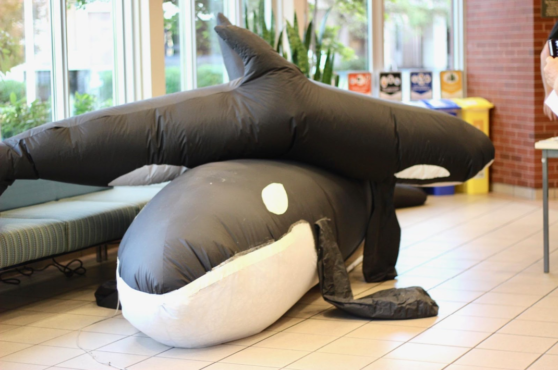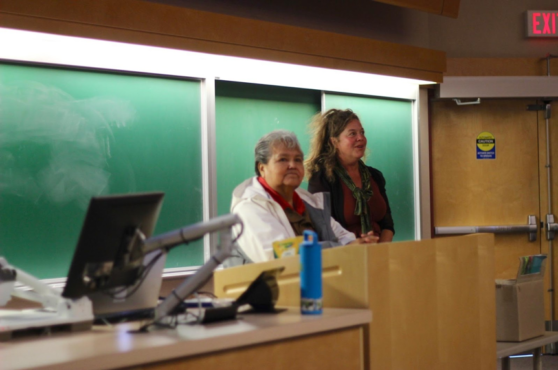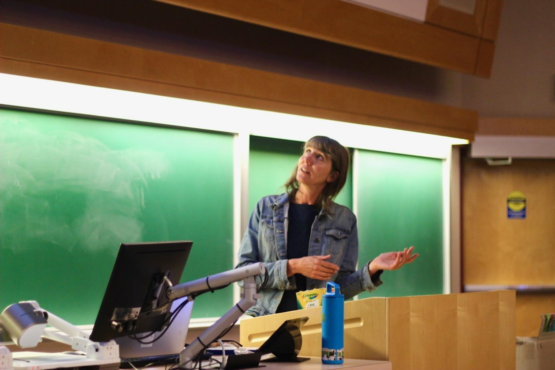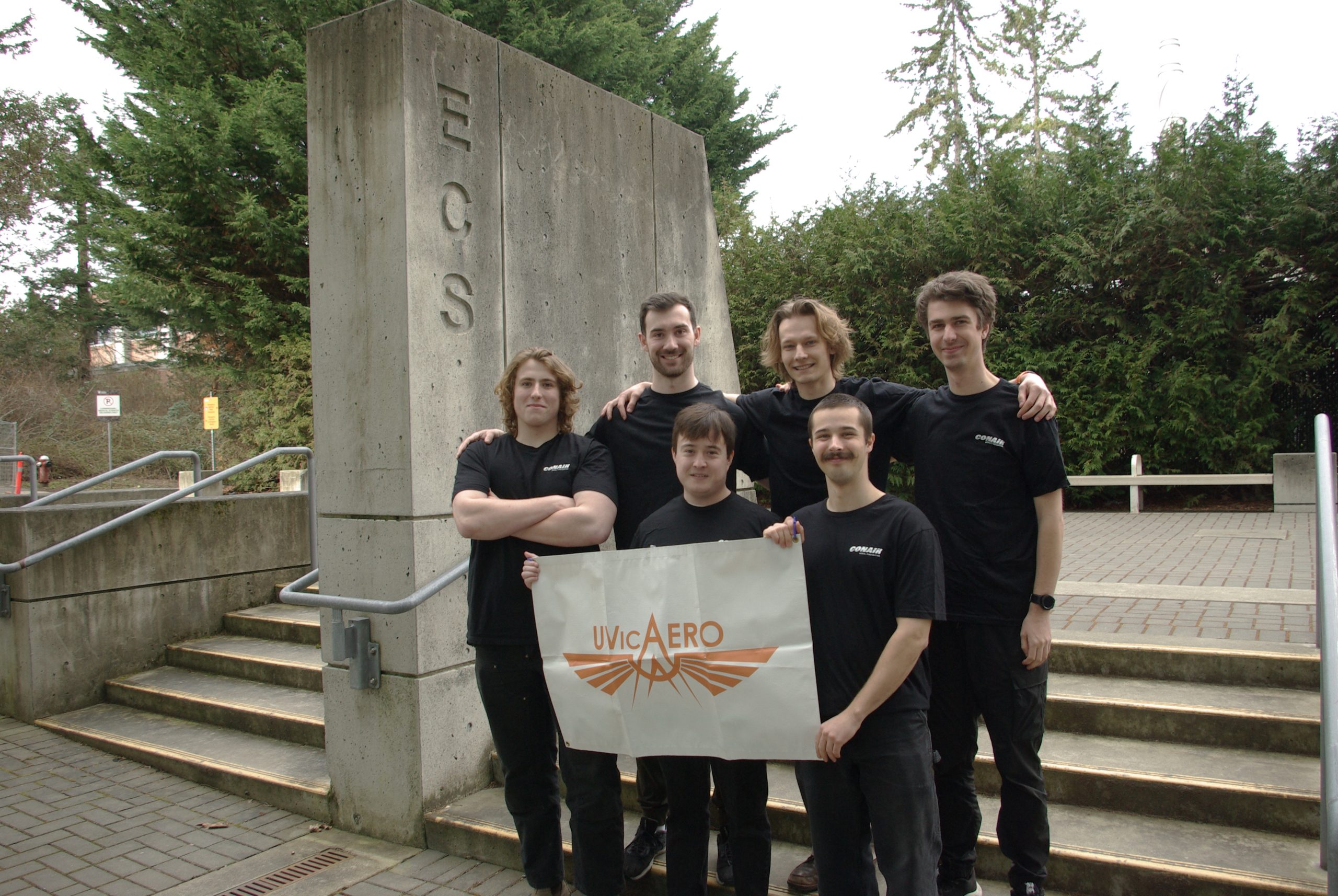Southern Resident Killer Whale town hall speaks to the future of the Salish Sea

Photos by Sarah Suleman, Contributing Writer.
“You saved my home,” said Joan Morris, a Lkwungen Elder.
The gravity of these four words still weighs heavy on me in the weeks following the “Protect What You Love: Southern Resident Killer Whale” town hall.
Held on Aug. 30 in the David Strong Building at UVic, concerned community members gathered to hear Director of the Raincoast Conservation Foundation’s Wild Salmon Program Misty MacDuffee and Saanich Council candidate Nathalie Chambers speak. The crowd was welcomed with a territorial acknowledgement by Morris.
The gathering landed on the heels of news that proposed construction for the Trans Mountain Pipeline expansion had been halted — a ruling that Chambers described as “synergistic divine intervention.”
Over the summer, there was public outcry when a Southern Resident Killer Whale carried the body of her dead calf for 17 days.
Both Chambers and MacDuffee are involved with the Raincoast Conservation Foundation, an organization responsible for one of many lawsuits opposing the construction of the pipeline. The aim of the town hall was to keep up momentum, and to educate attendees on the complexities that surround saving the Southern Resident Killer Whale (SRKW) population.
MacDuffee touched on problems plaguing their staple food — Chinook salmon — repercussions of environmental pollutants, and noise in the Salish Sea. More than anything, especially in conjunction with the Court of Appeal’s ruling to delay construction, she detailed why we all have reason to save the Salish Sea and protect the marine inhabitants we share it with.

Joan Morris and Nathalie Chambers.
The path to the court’s ruling
The existing Trans Mountain Pipeline, constructed in 1953, runs from Strathcona County, Alberta to Burnaby, B.C. In 2013, Texas-based energy corporation Kinder Morgan approached the National Energy Board (NEB) proposing to expand and twin the pipeline. In May 2016, the NEB green-lighted the project. Later that year, under the leadership of Prime Minister Justin Trudeau, the Federal Government followed suit and granted approval.
Between the time that that decision was made and now, nearly two dozen lawsuits have been filed against the proposal, primarily protesting a lack of First Nations consultations and a visible neglect of consequential environmental effects.
Even without the expansion, stressors on the Salish Sea are already apparent . Over the summer, there was public outcry when the SRKW Tahlequah, or J35, carried with her the body of her dead calf for 17 days, an unprecedented mourning period. At the end of the summer, the Federal Court of Appeal overturned the approval granted by the Federal Government, and although the news brought cause for celebration for Indigenous, scientific, and coastal communities, it was clear that the town hall attendees were far from giving up the fight.
Main source of food
Building off of the incredible energy in the room, MacDuffee dove straight in and outlined a number of issues, all of which equally plague the SRKW population. The first topic of the evening was the status of wild salmon populations.
“Chinook stocks are not at the levels that they once were,” she said, speaking of the the species’ almost exclusive choice of food.
MacDuffee pointed to hatcheries as having an adverse effect on salmon.
[The pipeline’s] path would cross more than 200 streams and rivers, many of which serve as crucial spawning environments for salmon.
“In the past, we always thought . . . the ocean had an unending, unlimited ability to feed and support salmon. But we know now that that is not the case. There are limits to the number of salmon that can be supported in the North Pacific.
“When we put so many hundreds of millions, if not billions, of hatchery salmon into the North Pacific, there’s only going to be so many salmon that are supported,” she said. “And that comes at a cost to those wild salmon populations.”
The proposed design for the pipeline expansion called for great concern as its path would cross more than 200 streams and rivers, many of which serve as crucial spawning environments for salmon. Increased stressors in these areas would contribute to the struggles that the SRKW population is already facing in relation to food sourcing.
Noise complaint
Perhaps one of the most important points drawn on by Macduffee was sound pollution.
“The Salish Sea has become a very noisy place if you are an animal that earns [their] living using sound,” she said.
The project proposal drafted by Kinder Morgan leaves out key details regarding the changing soundscape beneath the ocean’s surface, yet the number of tankers travelling through the Salish Sea per month would increase from five to 34 — a massive increase in noise output.
MacDuffee outlined three major ways that vessel noise can affect SRKWs. First, the noise generated from larger ships decreases the volume of space through which they can communicate. This can be incredibly debilitating for them, as they rely on echolocation to hunt.
“Right now, [the SRKWs] are in the presence of a vessel 85 per cent of the time.”
Second, vessels like whale watching boats that come in close proximity to the SRKWs, have engines operating with frequencies in the same bandwidth that the SRKWs communicate in.
“[This] masks their calls,” she explained. “There have been studies done showing that the whales essentially have to raise their voices in the presence of vessels.”
The third way that vessel noise affects the behaviour of SRKWs, MacDuffee said, is that “it changes their behaviour.”
If the expansion is ever granted approval, all three of these problems will be amplified.
“Right now [the SRKWs] are in the presence of a vessel 85 per cent of the time,” she said. With the expansion, that number could reach 92-100 per cent of the time.

Misty MacDuffee.
Oil spills
Kinder Morgan’s proposal to the NEB included safety precautions for how the transported oil would be handled, as well as plans for handling potential spills. Even with this acknowledgement, opponents continue to point out large risks with this expansion, particularly in terms of the SRKW population.
To illustrate these risks, the infamous Exxon Valdez oil spill was discussed at the town hall. This was when 10.8 million gallons of crude oil were spilled into Alaska’s Prince William Sound in 1989.
MacDuffee explained why this event is continuously referenced when speaking about the dangers of oil spills to whales.
With a 50 percent chance of extinction for this population in the next 100 years, things begin to look grim.
“[Because] it happened in a relatively pristine environment, so any declines in populations and species could be attributed to the oil spill,” she said.
This infamous spill not only caused great harm to the resident orcas, but one transient pod lost all of its breeding females, rendering the pod’s lineage functionally extinct.
Future of the whales
With a 50 percent chance of extinction for this population in the next 100 years, things begin to look grim. However, MacDuffee was optimistic, especially in conjunction with the court ruling, and in spite of the concerns discussed at the town hall.
“If we improve the abundance of chinook salmon and reduce that noise and disturbance, that’s where we [are] able to actually reverse the decline.”
Before attending the town hall, I couldn’t help but question why there are so many people who are so invested in saving these whales. With the mounting struggles they face, the battle may appear to be more trouble than it’s worth.
However, through the testimonies of MacDuffee and Chambers, people’s actions becomes much clearer.
People who live near the Salish Sea have the privilege of seeing what they are fighting for with their own eyes. These creatures are not mythical beings only seen on the pages of National Geographic. To the residents of the West Coast, the SRKWs are family.
As a community, we understand the incredible intelligence, emotion, and familial bonds that [the SRKWs] have.
With childlike enthusiasm, we press our faces to the glass on B.C. Ferries every time the captain announces a whale sighting, hoping to catch a glimpse. We climb into puffy red suits, hop on small, wobbly boats, and travel for hours through every weather condition possible just to be in their presence. As a community, we understand the incredible intelligence, emotion, and familial bonds that these animals have.
The intersection between the town hall and the ruling to delay the pipeline created, as Chambers put it, a “confusing, beautiful moment.”
It is clear that there is still much work to be done if the SRKWs are to be saved from extinction. But the news of the court’s decision diverges from the pessimistic narrative of all hope being lost. It signals that these issues are no longer being ignored. Instead, they are being discussed and considered and that in itself is an important step forward.







